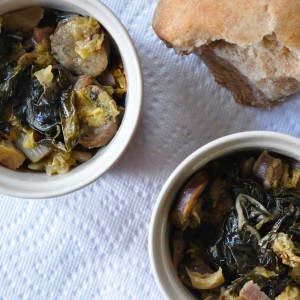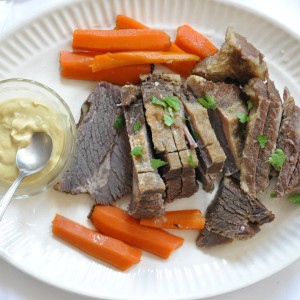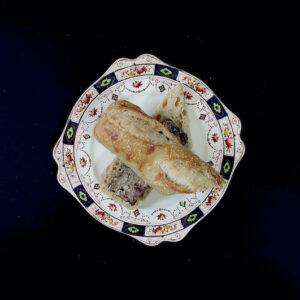Cottage Pie
In How To Eat, Nigella Lawson describes the British traditional Sunday lunch thus:
Proper British Sunday lunch is everything contemporary cooking is not. Meat-heavy, hostile to innovation, resolutely formalized, it is as much ritual as meal, and an almost extinct ritual at that.
With their military vocabulary and timetables, my English cookbooks concur with Lawson: English Sunday lunch is indeed a ritualistic affair, both in the preparation and consumption. Yet few cookbooks offer recipes for the dish eaten the next day, meant to finish off any leftovers: cottage pie.

Jane Grigson calls cottage pie “family Monday” food. Meaning it anything you’d serve to guests. Nor, if my English cookbooks are any indication, is it the sort of recipe one bothers jotting down, as everyone knows how to make it.
Fortunately for us, Mrs. Grigson did bother jotting it down, in more than place: there’s a recipe in British Food, and another in her delightful Food With the Famous. On October 27, 1794, Parson James Woodforde has cottage pie for dinner, with “neck of mutton, roasted.” Nevertheless, dinner is no comfort on this “dull, melancholy wet day,” for
our maid Molly is with child, but persists in it that she is not.
Grigson adds that the Parson and his niece, Nancy, found the mashed potato topping “a fairly novel charm.” Recall this recipe is from 1794; potatoes were not taken for granted as they are now.
Tamasin Day-Lewis also gives a recipe for cottage pie, in Supper For A Song, which I found quite helpful in constructing mine.

Returning to that potato topping. Mashed potatoes are an emotive food for many. Why this is I cannot say. To quote Fleetwood Mac, (out of context, but still) you can go your own way concerning mash–and everything else–but I had some cream on the verge of going off, so used it here.

Today’s mash also features parsnips, an underutilized vegetable here in America. I’ve no idea why this is so, but that applies to far more than parsnips these days.

Figure roughly the same amount of topping to filling. Or more, because when is there too much mashed potato?

Cottage pie takes a bit of time to make, but once it’s cooking, cottage pie is happy to sit in the oven on low heat for a few hours while you vaccine hunt. You can also assemble the meat and mash separately, refrigerate them, then assemble everything and heat them an hour before eating.
A few points:
Cottage pie was created to use up leftovers. It is also delicious made from scratch. I’ve prepared cottage pies from ground beef and ground pork, but feel free to use whatever you have: cooked leftover roast beef, cooked lamb, chicken. Mixtures of various kinds of meat work, too, so long are you are careful to avoid dryness.

The same goes for the mashed potato topping: use all potato, or add other root vegetables like parsnip, carrot, or rutabaga.

Every recipe I consulted added a spicing element: a smidge of cayenne, hot paprika, or a few shakes of tabasco. In other words, avoid stodginess.

Every recipe I read also added wine. What kind-red or white-is your call. If you prefer to avoid alcohol, broth or water make fine substitutions.

Cottage pie
While this recipe is my own–if such a thing can be said of any recipe–I am indebted to Tamasin Day-Lewis, Jane Grigson, and Nigella Lawson. The books I drew from were Supper For A Song, Food With The Famous, British Food, and How to Eat.
Cooking time: one hour simmering time for meat, twenty minutes for the potatoes to boil, then about forty minutes baking time.
Serves: 2-4
Please see notes before cooking
2-3 tablespoons olive oil for the pan; a little butter if wished, optional, or use all olive oil
one carrot, peeled and cut into coins
one small onion or shallot, peeled and chopped
1-2 garlic cloves, peeled and chopped
1 stick celery, sliced, optional
3-4 slices of bacon, finely chopped, optional
1 pound/454 grams raw ground pork or beef; you can also use leftover cooked meat from a roast, finely chopped. (see notes about meats)
1-2 tablespoons of tomato paste or catsup
Salt and pepper, to taste
Optional additions:
4 ounces/125 g frozen peas
A slug of Worcestshire sauce and/or hot sauce
Some spicy seasoning; this is personal, to taste: I added a 1/2 teaspoon of hot paprika
handful of grated cheddar or Parmesan cheese
2-4 ounces/75-125 ml red wine
A splash brandy
For the mashed potato topping:
You can make your preferred mash. If you need a recipe:
1 pound/454 g mashing potatoes, ideally Russet, peeled, sliced into chunks, and boiled in hot salted water
1 cup/8 ounces/227 g heavy cream (double cream)
salt and pepper, to taste
unsalted butter, to taste, optional
To make the pie:
A large sauté pan with a nonstick or enamel over steel surface is best here. I used my Staub “everyday” pan, which measures 14 inches/35cm.
Pour the olive oil into the pan. If you’re using butter, add it now. Turn the burner to medium low heat.
Put the carrot, onion, garlic, and celery, if using, into the pan and cook on medium low heat for about five minutes, letting the vegetables soften but not brown. If you’re using the bacon, add it as well, stirring so the fat lets down and moistens the vegetables.
If the pan is dry, add a bit more olive oil.
Add the pork or beef to the pan and break it up with a wooden spoon or other implement that won’t damage the pan’s surface, blending the meat and vegetables. Add the tomato paste or catsup, stirring for a few minutes to blend everything.
Now add any optional ingredients: peas, Worcestshire or hot sauce, hot paprika, the wine and splash of brandy. Stir to blend.
The fat from the meat should provide adequate liquid, but if the pan seems dry, you can add wine, broth, or even a little water. Allow the meat to simmer, uncovered, on medium low heat for about an hour.
While the meat cooks, prepare the mashed potato topping.
Boil the potatoes until fork tender, about 20 minutes. Drain. Return to pan. Mash with a potato masher. Pour in the cream and stir with a heat-proof spoon. Salt and pepper to taste; add butter, if wished. Remember you are adding these atop the meat, so they shouldn’t be too rich or runny…unless you like them this way.
Preheat the oven to 375F/190C
Pour the meat mixture into a baking dish or several smaller dishes, spreading it in an even layer.
I prefer to use one large baking dish, but if you want to give people their own pie and have enough oven-proof dishes–and diners in the time of Covid–go for it. This amount of food fills an 8×8/20cmx20cm that measures about 2 inches/6cm deep.
Spread the mashed potato atop the meat. Some people use a piping bag. I just use a spoon.
Bake the pie in the oven for about 40 minutes. You may need to turn the heat down about 25 degrees–keep an eye out to ensure it’s not burning on top.
Cottage pie will hold in a low oven for several hours, covered with foil.
Serve cottage pie with frozen peas and catsup.
Leftovers may be refrigerated up to three days. Reheat in a low oven or microwave.
To freeze, add more dairy to the mash to keep it mois, wrap the leftover portion snugly to prevent freezer burn and consume as soon as possible.
Notes:
Ingredients for cottage pie very flexible. You can use different meats, or less meat, depending on what you have, making up the bulk with mash. You can use cooked leftover meat, just take care to avoid dryness. Note that cooking time may be shorter.
We found leftovers only improved with time. If you’re willing to spend time with leftovers, buy that larger roast–it will pay off.

Nothing to do with anything, except it’s a nice picture, and this post is kinda scant on those.




